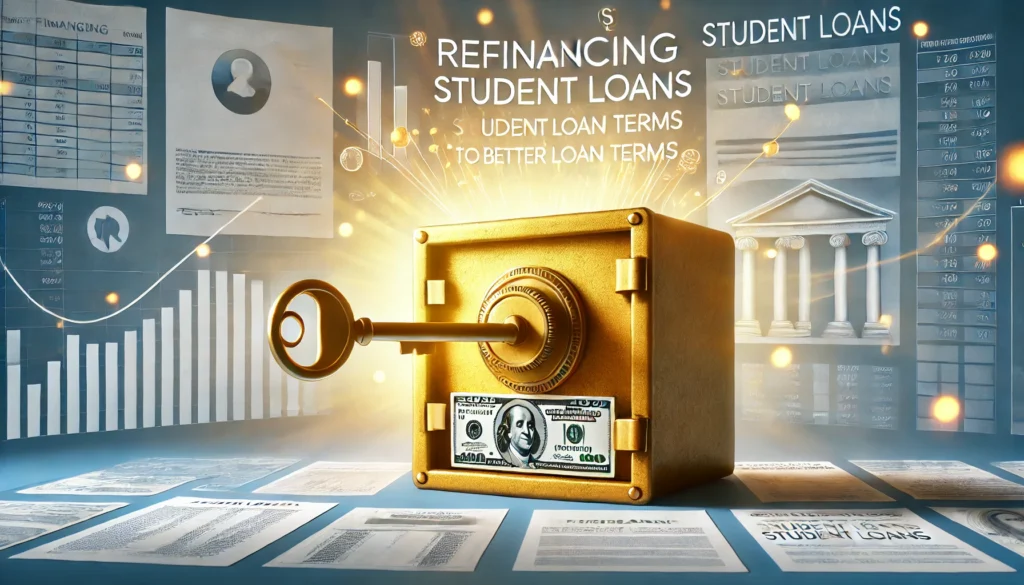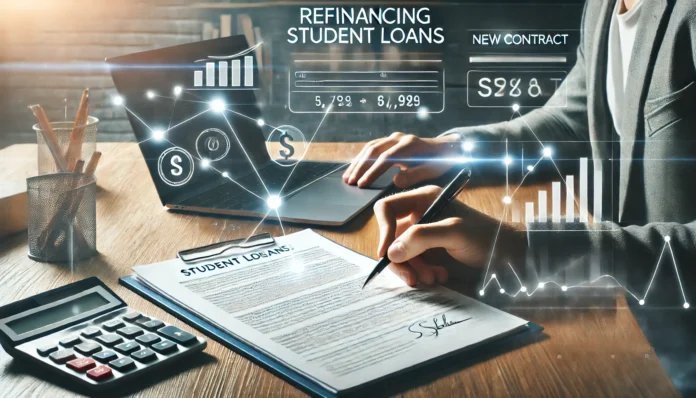Understanding Student Loan Refinancing and Its Purpose
Refinancing student loans is a financial strategy that allows borrowers to replace their existing loans with a new one, ideally under more favorable terms. Many graduates consider this option as they seek to manage their debt more efficiently, reduce interest rates, or consolidate multiple loans into a single, manageable payment. However, what happens when you refinance a student loan is not always straightforward, and understanding the full implications of this financial move is essential. While refinancing can provide significant benefits, it also comes with potential downsides that every borrower should consider carefully.
You may also like: Best Student Loan Refinance Options in 2025: Compare Rates & Save Thousands
At its core, refinancing involves securing a new loan from a private lender to pay off one or more existing student loans. The new loan may offer a lower interest rate, adjusted repayment terms, or enhanced flexibility, depending on the borrower’s creditworthiness and financial profile. However, refinancing is not always the best option for every borrower, particularly those with federal loans who may lose access to federal repayment programs and protections. Weighing the pros and cons of refinancing student loans can help borrowers make an informed decision that aligns with their long-term financial goals.

The Benefits of Refinancing Student Loans
One of the most compelling reasons to refinance student loans is the potential for substantial financial savings. Borrowers with high-interest student loans, especially those with private loans, can benefit from securing a lower interest rate through refinancing. A reduced interest rate means lower monthly payments and decreased total repayment costs over the life of the loan. In some cases, borrowers may save thousands of dollars, making refinancing an attractive option for those looking to improve their financial stability.
Another advantage of refinancing is the ability to consolidate multiple loans into a single payment. Many graduates have multiple student loans, each with different interest rates, repayment terms, and due dates. Refinancing simplifies repayment by combining these loans into one, reducing administrative burden and making it easier to manage monthly payments. This can be particularly helpful for borrowers juggling various financial obligations and seeking a more organized repayment strategy.
Refinancing also provides an opportunity for borrowers to adjust their loan terms to better suit their financial situation. Some may opt for a shorter loan term, allowing them to pay off debt faster and save on interest in the long run. Others may choose a longer repayment term, reducing their monthly payments and increasing cash flow for other financial priorities. The flexibility offered by refinancing makes it a viable option for borrowers with different financial goals and circumstances.
The Drawbacks of Refinancing Student Loans
Despite its benefits, refinancing is not without risks. One major disadvantage is the loss of federal loan protections and benefits. When borrowers refinance federal student loans with a private lender, they forfeit access to federal repayment programs such as income-driven repayment plans, loan forgiveness options, and deferment or forbearance protections. For borrowers who rely on these benefits, refinancing may not be the best choice.
Additionally, refinancing requires borrowers to meet strict eligibility criteria, including a strong credit score and stable income. Lenders assess these factors to determine the borrower’s risk profile, and those with lower credit scores or inconsistent earnings may struggle to qualify for the best refinancing rates. Some borrowers may need a cosigner to secure favorable terms, which can introduce additional financial responsibilities for the cosigner.
Interest rate variability is another potential downside. While many borrowers opt for a fixed interest rate to ensure predictable payments, some refinancing options include variable interest rates that can fluctuate over time. In a rising interest rate environment, borrowers with variable rates may see their payments increase, potentially negating the initial benefits of refinancing. Understanding the differences between fixed and variable rates is crucial for making an informed refinancing decision.
Who Should Consider Refinancing?
Refinancing is best suited for borrowers with strong credit histories, stable incomes, and private student loans with high-interest rates. Those who do not rely on federal loan benefits and seek to lower their overall repayment costs can benefit the most from refinancing. Additionally, borrowers who want to simplify their repayment process by consolidating multiple loans may find refinancing to be a practical solution.
However, borrowers with federal loans should carefully evaluate whether they can afford to lose access to federal protections. If they anticipate needing income-driven repayment options or potential loan forgiveness, keeping their loans within the federal system may be a wiser decision. Evaluating current financial health, future job stability, and long-term financial goals will help borrowers determine whether refinancing aligns with their needs.

Frequently Asked Questions (FAQ) on Refinancing Student Loans
1. What happens when you refinance a student loan, and how does it impact your financial future? When you refinance a student loan, your existing loan is replaced with a new loan that typically has a lower interest rate or different repayment terms. This can result in lower monthly payments, reduced overall interest costs, or a shorter repayment period. However, refinancing federal student loans means losing access to federal protections such as income-driven repayment plans and loan forgiveness programs. The impact on your financial future depends on whether the savings outweigh the benefits lost. Understanding what happens when you refinance a student loan helps borrowers make informed choices based on their long-term financial goals.
2. What are the pros and cons of refinancing student loans? The pros and cons of refinancing student loans vary depending on an individual’s financial situation and loan type. The advantages include lower interest rates, potentially saving thousands of dollars over time, and the ability to consolidate multiple loans into one simplified payment. However, drawbacks include losing access to federal protections and benefits, which can be crucial in times of financial hardship. Some lenders offer flexible repayment options, but these may not be as comprehensive as federal programs. Weighing the pros and cons of refinancing student loans ensures borrowers make decisions that align with their needs.
3. How do you determine if refinancing your student loans is the right choice? Determining whether to refinance a student loan depends on factors such as your current interest rate, credit score, and financial stability. If you have a high-interest rate and good credit, refinancing can provide significant savings. However, if you rely on federal benefits like deferment, forbearance, or loan forgiveness, refinancing may not be beneficial. Understanding what happens when you refinance a student loan allows borrowers to assess whether the new terms provide financial advantages. It’s essential to compare lender offers and calculate potential long-term savings before making a decision.
4. How does refinancing affect your credit score? Refinancing student loans can have both positive and negative effects on your credit score. When you apply, lenders perform a hard inquiry, which may temporarily lower your score. However, successfully refinancing into a lower interest rate with consistent, on-time payments can improve your credit over time. Since refinancing consolidates multiple loans into one, it can also enhance your credit utilization ratio. Evaluating the pros and cons of refinancing student loans includes considering the short-term impact on credit versus long-term financial benefits.
5. What types of student loans can be refinanced? Both federal and private student loans can be refinanced, but the implications differ significantly. Private student loans can often be refinanced for better rates without losing significant benefits. Federal student loans, however, lose protections such as income-driven repayment plans and Public Service Loan Forgiveness when refinanced. Understanding what happens when you refinance a student loan helps borrowers determine whether they are willing to trade federal benefits for potential savings. It’s crucial to review all options before making the switch to private refinancing.
6. Can you refinance student loans multiple times? Yes, student loans can be refinanced multiple times, provided you meet the lender’s eligibility criteria. Many borrowers choose to refinance again if interest rates drop or their credit score improves. The pros and cons of refinancing student loans multiple times include gaining access to better terms but also the potential for additional credit inquiries and fees. Refinancing repeatedly can also extend the repayment period, leading to more interest paid over time. Evaluating the benefits of each refinance ensures it aligns with long-term financial goals.
7. What factors influence your eligibility for refinancing student loans? Several factors determine eligibility for refinancing, including credit score, income level, and debt-to-income ratio. Lenders typically require a strong credit profile and stable employment to qualify for the best rates. Understanding what happens when you refinance a student loan involves considering how these factors impact interest rates and approval odds. Some lenders allow co-signers to help borrowers qualify for better terms. Strengthening your credit and financial profile can increase the likelihood of securing a favorable refinancing deal.
8. Are there any fees associated with refinancing student loans? Most lenders do not charge application or origination fees for refinancing student loans, but some may impose prepayment penalties or service fees. Reviewing the pros and cons of refinancing student loans includes assessing any hidden costs that may reduce overall savings. Comparing lenders and reading the fine print ensures borrowers understand all associated fees before refinancing. While refinancing can lead to long-term savings, unexpected costs could diminish the benefits. Always confirm all potential charges with the lender before committing to a refinancing agreement.
9. How does refinancing student loans impact repayment flexibility? Refinancing student loans can increase or decrease repayment flexibility, depending on the lender and loan terms. Some lenders offer deferment and forbearance options, but they may not be as extensive as federal loan protections. Understanding what happens when you refinance a student loan involves recognizing the trade-off between potential savings and flexible repayment options. Borrowers should seek lenders that provide repayment assistance programs in case of financial hardship. Ensuring that the refinanced loan includes sufficient flexibility can help mitigate financial risk in the future.
10. What are the best strategies for getting the lowest refinancing rates? Securing the lowest rates when refinancing student loans requires a strong credit score, stable income, and comparison shopping. Borrowers should check rates from multiple lenders to find the most competitive offers. Improving creditworthiness before applying can result in lower interest rates and better terms. Understanding the pros and cons of refinancing student loans helps in identifying the best timing and lender for refinancing. Using loan comparison tools and negotiating with lenders can maximize potential savings and secure the best refinancing deal.

Conclusion: Making the Right Choice
Refinancing student loans offers both advantages and disadvantages, and the decision to refinance should be based on a thorough assessment of one’s financial situation and repayment needs. Understanding what happens when you refinance a student loan allows borrowers to make informed decisions about their financial future. While refinancing can lead to lower interest rates, simplified repayment, and customized loan terms, it also comes with trade-offs, including the loss of federal protections.
For those with strong credit and stable incomes, refinancing can be a powerful tool for achieving financial freedom. However, borrowers should carefully weigh the pros and cons of refinancing student loans before committing to a new loan structure. By considering both the benefits and potential drawbacks, individuals can make the best choice to support their long-term financial well-being.
Tags: student loan refinancing, loan repayment strategies, financial planning for graduates, managing student debt, debt consolidation options, interest rate reduction, private student loan refinance, credit score improvement, financial stability, loan term adjustment, student loan interest rates, refinancing eligibility, fixed vs. variable rates, best lenders for student loan refinancing, debt-to-income ratio, cosigner benefits, income-driven repayment, federal vs. private loans, loan consolidation benefits
Further Reading:
Pros and cons of refinancing student loans
The Pros and Cons of Refinancing Student Loans
Pros and cons of student loan refinancing
Legal Disclaimer
The information provided in this article is for general informational purposes only and is not intended to constitute financial, investment, legal, tax, or other professional advice. The content should not be relied upon for making any financial or investment decisions. Readers are encouraged to consult with licensed professionals, such as financial advisors, attorneys, or tax experts, to obtain personalized advice tailored to their individual circumstances. The author and publisher disclaim any liability for any actions taken or not taken based on the information provided in this article.





